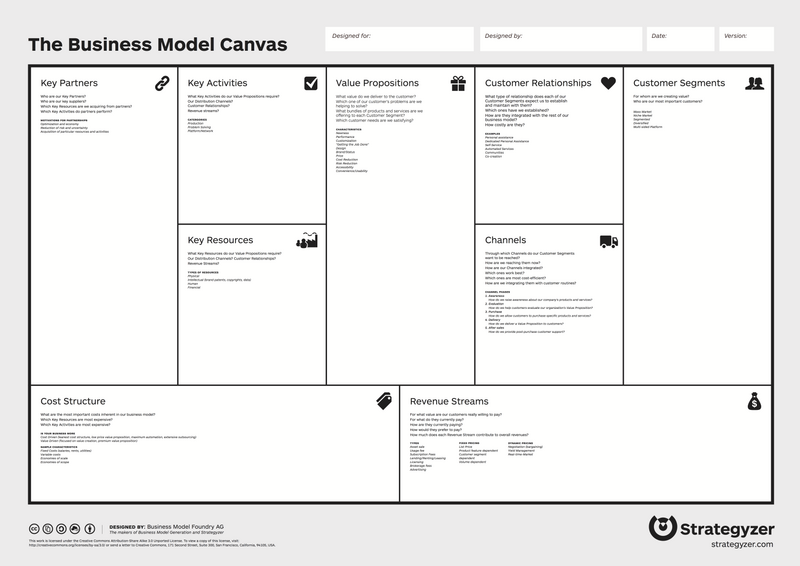Business model canvass
The Business Model Canvas is a way to think through how you
- turn your idea into an activity that can sustain itself and
- communicate its "business model" quickly, briefly, and simply.
Nine building blocks of the business model tell your story: Partners deliver Resources through Activities so you can transform them by creating Value. This affects your Cost Structure. Each Customer Segment receives value through Channels and builds a Relationship. This shapes your Revenue Streams. The canvas lets you flesh out each part and see how they relate to each other.

How to use the Business Model Canvas
- Draw the 9 blocks on a white board or big piece of paper.
- Put post-it notes, placeholder language, and quick sketches in each block
- Visualize how the blocks interact and adjust your model
- Take snapshots before and after major changes
- Color code post-its or markers to a particular customer segment
The Building Blocks To Imagine
Revenue Streams
- For what value are our customers really willing to pay?
- For what do they currently pay?
- How are they currently paying?
- How would they prefer to pay?
- How much does each Revenue Stream contribute to overall revenues?
TYPES:
- Asset sale
- Usage fee
- Subscription Fees
- Lending/Renting/Leasing
- Licensing
- Brokerage fees
- Advertising
FIXED PRICING:
- List Price
- Product feature dependent
- Customer segment dependent
- Volume dependent
DYNAMIC PRICING:
- Negotiation (bargaining)
- Yield Management
- Real-time-Market
Customer Segments
- For whom are we creating value?
- Who are our most important customers?
- Mass Market
- Niche Market
- Segmented
- Diversified
- Multi-sided Platform
Value Propositions
- What value do we deliver to the customer?
- Which one of our customer’s problems are we helping to solve?
- What bundles of products and services are we offering to each Customer Segment?
- Which customer needs are we satisfying?
characteristics
- Newness
- Performance
- Customization
- "Getting the Job Done"
- Design
- Brand/Status
- Price
- Cost Reduction
- Risk Reduction
- Accessibility
- Convenience/Usability
Key Activities
- What Key Activities do our Value Propositions require?
- Our Distribution Channels?
- Customer Relationships?
- Revenue streams?
CATEGORIES
- Production
- Problem Solving
- Platform/Network
Key Partners
- Who are our Key Partners?
- Who are our key suppliers?
- Which Key Resources are we acquairing from partners?
- Which Key Activities do partners perform?
motivations for partnerships* Optimization and economy
- Reduction of risk and uncertainty
- Acquisition of particular resources and activities
Key Resources
- What Key Resources do our Value Propositions require?
- Our Distribution Channels? Customer Relationships?
- Revenue Streams?
types of resources
- Physical
- Intellectual (brand patents, copyrights, data)'
- Human
- Financial
Cost Structure
- What are the most important costs inherent in our business model?
- Which Key Resources are most expensive?
- Which Key Activities are most expensive?
is your business more
- Cost Driven (leanest cost structure, low price value proposition, maximum automation, extensive outsourcing)
- Value Driven (focused on value creation, premium value proposition)
sample characteristics
- Fixed Costs (salaries, rents, utilities)
- Variable costs (that rise as you deliver more of the good or service)
- Economies of scale
- Economies of scope
Customer Relationships
- What type of relationship does each of our Customer Segments expect us to establish and maintain with them?
- Which ones have we established?
- How are they integrated with the rest of our business model?
- How costly are they?
examples
- Personal assistance
- Dedicated Personal Assistance
- Self-Service
- Automated Services
- Communities
- Co-creation
Channels
- Through which Channels do our Customer Segments want to be reached?
- How are we reaching them now?
- How are our Channels integrated?
- Which ones work best?
- Which ones are most cost-efficient?
- How are we integrating them with customer routines?
channel phases
- Awareness. How do we raise awareness about our company’s products and services?
- Evaluation. How do we help customers evaluate our organization’s Value Proposition?
- Purchase. How do we allow customers to purchase specific products and services?
- Delivery. How do we deliver a Value Proposition to customers?
- After sales. How do we provide post-purchase customer support?
Credits
Adapted from cc licensed work (Designed by Business Model Foundry AG, The makers of Business Model Generation and Strategyzer. This work is licensed under the Creative Commons Attribution-Share Alike 3.0 Unported License.)